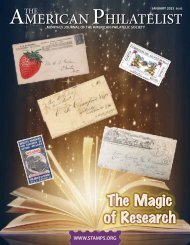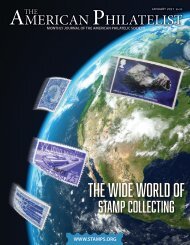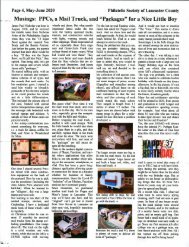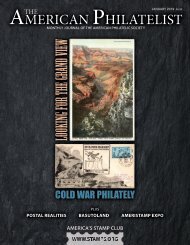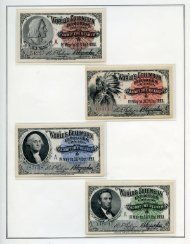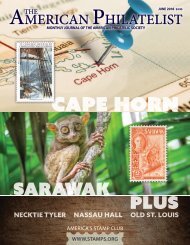July 2018 - Sneak Peek
The American Philatelist is the monthly journal of the American Philatelic Society, the world's largest organization for stamp collectors and enthusiasts. Members receive the printed magazine and can access the digital edition as a benefit of membership in the Society. Please enjoy this sneak peek. We're confident that once you see all that we offer, you'll want to join the APS today.
The American Philatelist is the monthly journal of the American Philatelic Society, the world's largest organization for stamp collectors and enthusiasts. Members receive the printed magazine and can access the digital edition as a benefit of membership in the Society. Please enjoy this sneak peek. We're confident that once you see all that we offer, you'll want to join the APS today.
You also want an ePaper? Increase the reach of your titles
YUMPU automatically turns print PDFs into web optimized ePapers that Google loves.
Like many of you, I started collecting stamps from across<br />
the world. That was more than 50 years ago. Childish<br />
thinking likely said I could collect every stamp ever<br />
printed. Within a few years I was specializing. But about five<br />
years ago I realized how much I missed worldwide stamps. So<br />
I started recollecting the world, but this time I was smarter.<br />
I limited my choices. I might focus on the first 200 or 300<br />
stamps of one country. Or perhaps I might pluck a single set,<br />
or just a couple stamps, from the 1930s. Or maybe I’d focus<br />
on a modern group or a long-running annual series. I was<br />
doing what we advise others: collect what you like.<br />
Here is a set I could not resist: Portugal’s Equestrian Seal<br />
of the King, Denis. I just always called it the knight stamp.<br />
Sometimes this is called the Medieval Knight stamp or the<br />
Portuguese Cavalinho (Little Horse) stamp.<br />
I remember when I was a child getting several used versions<br />
of this stamp in the set’s many vivid colors: from dark<br />
and light green to deep purple and vibrant red-orange. What<br />
little kid wouldn’t be drawn to this stamp of a brave knight<br />
in armor and shield astride a galloping fully dressed horse?<br />
Perhaps he’s out to battle a ferocious fire-breathing dragon?<br />
And with sword drawn – as a lefty – no less! (I can find no<br />
evidence that the king was left-handed, so I guess this was the<br />
artist’s prerogative.)<br />
Later I found out that the knight<br />
has a name. He is King Denis, known<br />
as Diniz or Dinis, in Portugal. Denis<br />
(1261-1325) – the Poet King or Farmer<br />
King – was Portugal’s sixth king, reaching<br />
the throne while still a teenager in<br />
1279, but serving more than 46 years<br />
until 1325.<br />
The son of Afonso III, Denis is<br />
credited with improving Portugal’s<br />
economy by strengthening the nation’s<br />
agricultural base and encouraging ship<br />
building, trade fairs and forestry plantations.<br />
He reduced the power of the<br />
nobility and the church. He had been<br />
educated to both French and Castilian<br />
cultural influences and became a competent<br />
poet. He founded the first university<br />
in Portugal — in Lisbon — in 1290. A skilled<br />
negotiator, Denis was able to establish with<br />
Castile a definitive frontier for Portugal.<br />
The handsome set of 16 definitives – No.<br />
761 to 775 in the Scott catalog – was almost entirely issued<br />
in 1953. The 30-cent rose lilac (Scott 763A) was released in<br />
1956. Each stamp has its own color and a unique denomination,<br />
from 5 cents to 50 escudos; no denomination was reprinted<br />
in a different color.<br />
The stamps were produced by lithography in panes of 100<br />
on a 10-by-10 grid by Casa da Moeda. They are perforated<br />
at 12½ and unofficially (because I measured them) are 24<br />
millimeters by 19 millimeters. The workhorse stamps stayed<br />
The King Denis, or Medieval Knight,<br />
stamps were issued in the 1950s, but<br />
not withdrawn from use until the early<br />
1970s. Covers such as this one showing<br />
the stamps’ use in 1965 are common.<br />
on sale for about 20 years and were withdrawn from sale in<br />
groups over four years from 1972 to 1975. The 20-cent, with a<br />
print run of 50.7 million, and the 50-cent, with a run of 33.1<br />
million, are the most common. The smallest run was for the<br />
high value 50 escudo with 180,000.<br />
A 2013 Afinsa specialized catalog for Portugal reports<br />
that because of all the colors and lengthy time of sale – more<br />
were printed when necessary – that there are many varieties<br />
and some errors.<br />
Philatelist Armando Mário O. Vieira, who in 1984 was<br />
awarded the Crawford Medal by the Royal Philatelic Society<br />
London, wrote a book about the stamp titled O Cavaleiro<br />
Medieval (The Medieval Knight). The 167-page book was<br />
published in 1996. I have not seen the book, but an online<br />
summary states: “The author describes the general characteristics<br />
of this issue and elaborates a catalog of 600 stamps<br />
with imperfections and defects, which are valuable because<br />
of their rarity.”<br />
Jaime Martins Barata (1899-1970) – a Portuguese painter,<br />
teacher, designer and scholar – designed the stamps. Barata’s<br />
big break as an artist came in 1940 at the Portuguese World<br />
Expo, for which he painted a series of large panels representing<br />
scenes from the country’s history. The artist also was invited<br />
by the Portuguese Post Office to design a commemorative<br />
stamp of the event. Barata created more stamps for the<br />
postal service and in 1947 was appointed art consultant to the<br />
Portuguese post office, a position he held until his retirement.<br />
Barata is credited with the designs of several other Portuguese<br />
stamps, including the Caravels of 1943 (the artist<br />
actively participated throughout his life in the historical debate<br />
over the transition to the Portuguese caravel of the 15th<br />
JULY <strong>2018</strong> / AMERICAN PHILATELIST 651




